Lambreken is a special part of the curtains that hides fastenings and eaves, perfectly overlaps the upper, not always the most attractive part of the curtains. It is a lambrequin that allows the drapery to give the features of logical completeness, attractiveness. Sew the lambrequin is not as difficult as it may seem, often it is simply formed on a special mounting bar. Today, various forms of lambrequins are distinguished, they all differ in the appearance used for the operation of the tissue, form and size of the folds. Most often the Swags are used, but there are also combined lambrequins that combine the features of 2-3 designs.
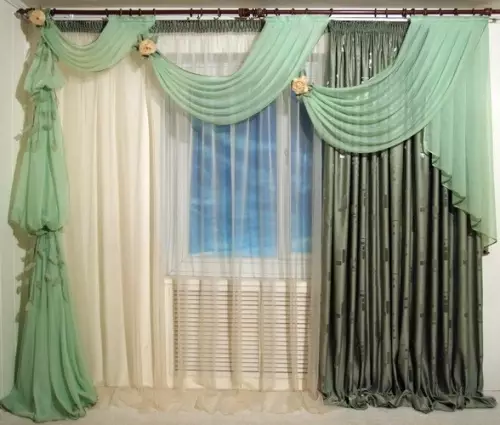
The choice of shade depends on the total tone of the interior and the tasks set.
What are the features of sewing?
The lambrequins are sewing from the easiest details. This will allow you to fulfill more complex work over time, creating your own hands the most beautiful interior of the house. Equipical cake is used quite often, sewing the lambrequin of this type can be from a suitable cutting of the tissue. It is formed into the folds directly on the mounting bar with a covered tissue. For example, it is necessary to sew a lambrene with such indicators:
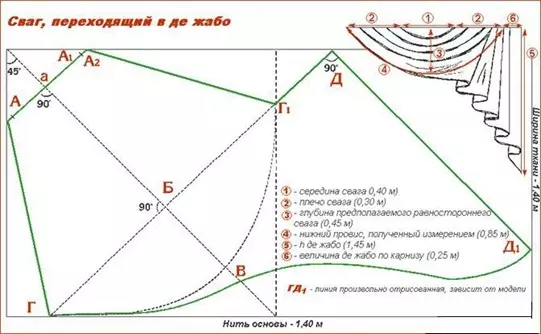
The scheme of the depth of the folding lambrequin.
- A perpendicular line is performed to the fibomb of the fabric, after which half the width for the peroxide is postponed on it - it is 42 cm.
- The distance is measured from the folding distance for the first fold minus 5 cm: 17-5 = 12 cm.
- Half of the upper arc is noted for provisions from the ceiling, after which 49 cm is measured in the collar. All the points of half of the lambrequin are connected, half the lower arc wire is noted.
- From the top point of the edge you need to mark the depth for the peroxide. Considering the coefficient 2, the number is: 44 * 2 = 88 cm.
- From the lower point of the folds of the Niza, the perpendicular line is noted to the bend itself. From the lower point of the tissue edge, a smooth arc is carried out, the length of which is 82 cm (72 + 10 = 82), 10 cm is added to process the seams.
Article on the topic: Outdoor hangers (including racks) for clothes, suits, shirts, trousers
How is the cutting fabric?
After the pattern is ready, you can begin to disclose. It is necessary to do it on a flat surface, the usual wide table is perfect. All the excess of it must be removed, but pins, needles, soap pieces to put closer, so as not to look for them if necessary. During the cutting, we must not forget that all markers on the contour of the pattern are carried out taking into account the transmission for seams. It is necessary to additionally add 5 cm on the seams, this line is noted by a dotted line so that during the sewing does not confuse.
When the pattern is ready, you can perform sewing and formation of the lambrequin itself. First you need to process all the seams so that the edges of the fabric become neat and the threads did not fly during operation. The mounting bar is fully covered with the cloth, it is done very tightly, the foundation should not be seen. After that, the bar is temporarily attached at a convenient height (for example, on the backs of 2 chairs), after which the tissue is started.
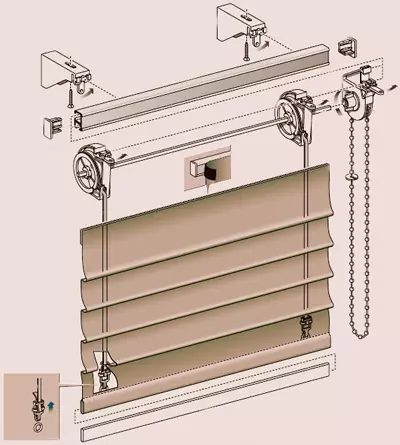
Fastening the curtains to the eaves.
The first of the top edges of the canvas are first attached, forming the upper provisis, the fabric is fixed with a needle. After provisis, you can start laying the first fold on the left, it is attached to a conventional tailoring pin. After that, all other folds are formed in the required quantity, leaving the depth of provisions in 44 cm. All excess fabric on the sides carefully removes, clipped with scissors along a flat line.
Pins are cleaned, the fabric is spreads on a flat surface. As a result, it turns out a semicircle with edges having teeth. The lower and upper edge of the fabric can be treated with oblique baking so that Lambreken acquired a more attractive appearance. The fabric is going to the folds, stitching on the typewriter. After that, it is necessary to secure the finished lambrequen on the mounting plate, the edges thumping back to the mounting is not visible. The fabric can be attached to a needle and thread, that is, the edges are sewn in place. Such equilateral cakes for one curtain can be done several, use a type of "scarf", in which during the construction of the pattern it is left as a part of the tissue hanging on the desired length. In this case, we need to pay much attention to how folds will be formed. Otherwise, tailoring is almost no different.
Article on the topic: Hydrangea - shrub varieties, landing and care. Photo of hydrangea
An example of a two-color Swag.
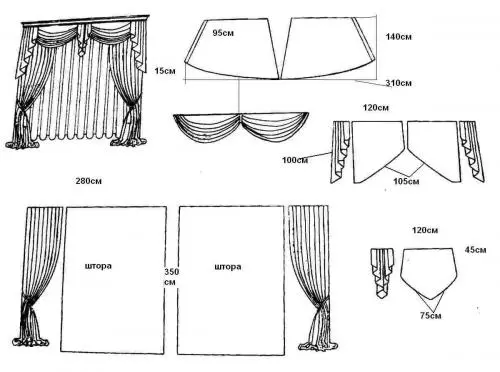
Pattern pattern lambrequin.
Correctly sew the lambrequins in the form of a double-sided match is quite simple. It is necessary to use the pattern that was already considered above. It is necessary to take a large sheet of tight paper, folded it in half to get ½ part of the square. After that, the pattern is transferred to a sheet of paper from folding, cuts out. As a result, it turns out a full-size image of the future wagon. Since the two-color design is needed, then this pattern should be divided into 2 parts. There is a line in the form of an arc at the required height, it is usually ½ of all height. A neat cut is performed on this line, it turns out already 2 patterns for tissue of different colors.
Now it is necessary to prepare such materials and tools:
- Fabric 2 colors and lining. It is best to select contrasting colors so that the Swag looked attractive and bright. Otherwise, shades will be small, the whole idea will be simply spoiled. For lining, you can take the cloth of another color, but it must be remembered that their textures should be the same.
- Threads in tone, needles, tailoring pins, scissors, cm and metal long line.
- Acquire and oblique beyk for finishing.
The sewing process is practically no different from the previous version, just now form folds for 2 parts of the tissue. After all the folds are assembled, the surplus is neatly cut off, the seams are processed.
When forming, it is recommended to determine the color in such a way that with a dark curtain intermediate color was brighter and vice versa.
The mounting bar is winding with that tissue that is used for the upper provision.
How to lay folds?
For lambrequin, folds are often used, which give the whole design soft, elegant appearance. But these folds can be completely different, it is necessary to lay them correctly, counting not only the quantity, but also the size, the depth of their provis.
Article on the topic: The distance between the pipes of a warm floor: Tips for definition
Today apply 3 types of such folds:
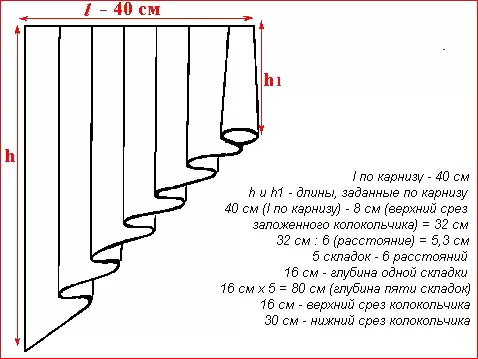
The lambrequin scheme "Double bell".
- One-way, which goes only in one direction.
- Counter, which are formed towards each other.
- Bowes, which are an involving side of the previous type - counter. After the formation, they resemble small bows, divergent. It is necessary to correctly determine the number of such folds, as it should not be too much, but also too small the amount of beauty Lambreken will not give.
For more beautiful design, the porter uses lambrene. This design is made of soft or very hard tissue, which not only masks the cornice and attachment of the curtains, but also gives the curtains an attractive and finished appearance.
For sewing, you can use different types of lambrequins, the level of complexity depends on which type was selected.
